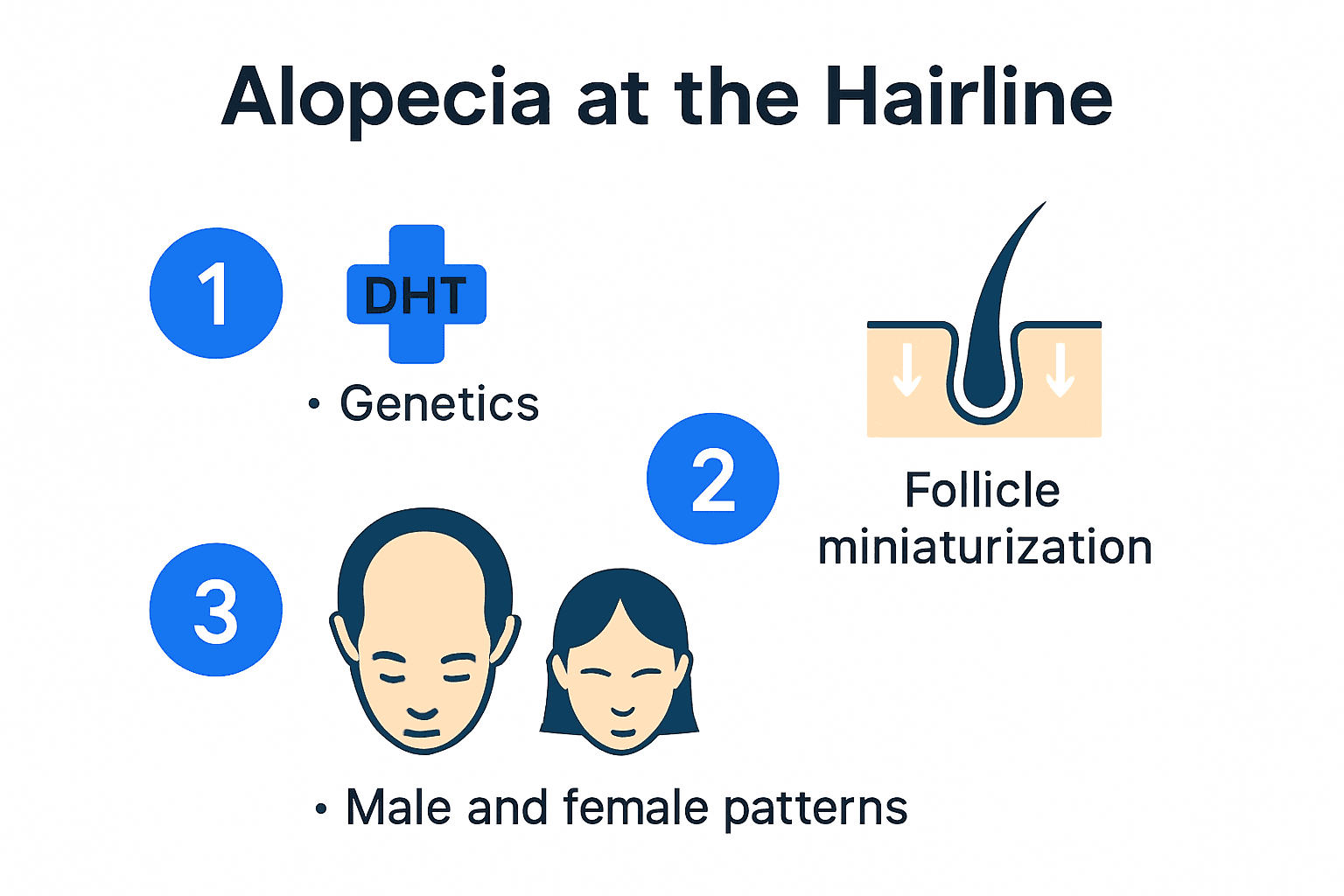Blog
Learning Materials
Alopecia on Hairline: Causes, Signs, and New Solutions 2025
Updated: July 26, 2025

Hairline alopecia is creeping up in conversations everywhere and for a good reason. Nearly 50 percent of men and women experience this subtle yet persistent type of hair loss, yet most miss the early warning signs hiding in plain sight. The real surprise is that a new wave of treatments, powered by precision diagnostics and regenerative medicine, is making it possible to finally outsmart what once felt inevitable.
Table of Contents
- Understanding Alopecia on Hairline
- Early Signs and Risk Factors to Know
- Personalized Treatment and Growth Tracking Options
- Partnering with Brands for Better Hair Care
Quick Summary
| Takeaway | Explanation |
|---|---|
| Understand the biological causes of hairline alopecia | Hairline alopecia is influenced by genetic predisposition and androgen sensitivity, particularly to DHT, affecting men and women differently. |
| Recognize early signs for timely intervention | Early indicators include gradual thinning, a receding hairline, and widening parts, enabling proactive management. |
| Embrace personalized treatment options | Advanced diagnostic tools and personalized approaches offer effective hair loss management, focusing on individual needs and progress. |
| Monitor risk factors related to hair loss | Factors like hormonal imbalances, stress, and nutritional deficiencies can increase the likelihood of hairline alopecia, necessitating regular assessments. |
| Collaborate with brands for innovative hair care solutions | Partnerships focusing on scientific research and personalized treatment can lead to more effective solutions for managing hair loss conditions. |
Understanding Alopecia on Hairline
Alopecia on the hairline represents a complex and often distressing hair loss condition that impacts millions of individuals worldwide. This specific type of hair loss targets the frontal hair region, creating unique challenges for those experiencing it. Understanding the nuanced nature of hairline alopecia requires a comprehensive examination of its underlying mechanisms and manifestations.
The Biological Mechanisms of Hairline Hair Loss
Hair loss at the hairline occurs through multiple intricate biological pathways. Research from the National Institutes of Health reveals that androgenetic alopecia is a genetically predetermined disorder characterized by an excessive response to androgens. This condition affects up to 50% of males and females, with distinctive patterns of hair loss. In males, the hair loss typically manifests as a receding hairline, while females experience more diffuse thinning with the frontal hairline often remaining relatively intact.
The hair follicle's sensitivity to hormonal changes plays a critical role in this process. Dihydrotestosterone (DHT), a potent androgen, can shrink hair follicles, progressively shortening the hair growth cycle. This hormonal interaction leads to miniaturization of hair follicles, resulting in thinner, shorter hair and eventually complete follicular shutdown in affected areas.

Clinical Manifestations and Progression
According to the American Academy of Dermatology, frontal fibrosing alopecia (FFA) represents a particularly aggressive form of hairline alopecia. This condition destroys hair follicles, causing permanent hair loss along the front and sides of the head. Early detection becomes paramount, as timely intervention by a dermatologist can potentially halt the disease's progression and minimize permanent damage.
Clinical observations indicate that hairline alopecia can present through several distinct patterns. Some individuals experience gradual recession, while others might encounter more rapid and pronounced hair loss. The progression often depends on genetic predisposition, hormonal factors, and individual physiological responses.
Emerging Understanding and Future Perspectives
Modern research continues to unravel the complex mechanisms underlying hairline alopecia. Advances in genetic mapping and molecular understanding are providing unprecedented insights into potential targeted treatments. Check out our comprehensive guide on personalized hair loss solutions to explore cutting-edge approaches for managing this condition.
The intricate nature of hairline alopecia demands a multifaceted approach. While genetic factors play a significant role, environmental influences, stress levels, nutritional status, and overall health contribute to the complex landscape of hair loss. Understanding these interconnected factors enables more nuanced and personalized treatment strategies, offering hope to those experiencing this challenging condition.
Early Signs and Risk Factors to Know
Recognizing the early signs of alopecia on the hairline can be crucial for timely intervention and management. Hair loss is a complex condition with multiple indicators that extend beyond simple visual changes. Understanding these early warning signs and associated risk factors empowers individuals to take proactive steps in their hair health journey.
Subtle Indicators of Hairline Alopecia
According to the American Academy of Dermatology, early signs of hair loss can be remarkably subtle. These initial indicators often develop gradually, potentially spanning months or even years before becoming overtly noticeable. Key early signs include a gradual thinning of hair on the head, a receding hairline, and a widening part.
Unique diagnostic markers can help identify potential hair loss. Research from the National Institute of Arthritis and Musculoskeletal and Skin Diseases highlights specific characteristics such as sudden loss of round or oval hair patches and the presence of 'exclamation point' hairs. These short, broken hairs are narrower at their base than their tip, serving as a critical visual indicator of potential alopecia development.

Comprehensive Risk Factor Assessment
Multiple risk factors contribute to the likelihood of developing alopecia on the hairline. Genetic predisposition stands as the most significant determinant. Statistical research from StatPearls confirms that androgenetic alopecia affects up to 50% of males and females, with distinct manifestation patterns.
Beyond genetics, several additional risk factors emerge:
- Hormonal Imbalances: Significant fluctuations in androgens and other hormones can trigger hair loss
- Autoimmune Conditions: Individuals with existing autoimmune disorders have a higher probability of developing alopecia
- Stress Levels: Chronic psychological and physiological stress can accelerate hair follicle miniaturization
- Nutritional Deficiencies: Inadequate protein, iron, and vitamin intake can compromise hair health
Here is a summary table of the main risk factors for hairline alopecia and their impact based on the article.
| Risk Factor | Description | Impact on Hairline Alopecia |
|---|---|---|
| Genetic Predisposition | Family history of androgenetic alopecia | Most significant determinant |
| Hormonal Imbalances | Fluctuations in androgens and other hormones | Can trigger or worsen hair loss |
| Autoimmune Conditions | Pre-existing autoimmune disorders | Greater probability of alopecia |
| Stress Levels | Chronic psychological or physiological stress | Accelerates hair follicle miniaturization |
| Nutritional Deficiencies | Inadequate protein, iron, vitamin intake | Compromises hair health |
Proactive Monitoring and Early Detection
Explore our personalized hair loss solutions to understand your unique risk profile. Early detection involves consistent self-monitoring and professional consultation. Tracking changes in hair density, texture, and growth patterns provides valuable insights.
Individuals should pay special attention to:
- Increased hair shedding during washing or brushing
- Visible scalp through existing hair
- Changes in hair texture or volume
- Unexplained hair thinning at the hairline
Understanding these early signs and risk factors transforms hair loss from an inevitable condition to a manageable health concern. By recognizing potential indicators and seeking timely professional guidance, individuals can develop targeted strategies to mitigate hair loss progression and maintain optimal hair health.
Personalized Treatment and Growth Tracking Options
Managing alopecia on the hairline requires sophisticated, individualized approaches that go beyond traditional one-size-fits-all treatments. Modern medical advancements have dramatically transformed our ability to track, understand, and address hair loss with unprecedented precision and personalization.
Advanced Diagnostic and Tracking Technologies
Research published in PubMed has developed groundbreaking non-invasive methodologies for assessing hair growth parameters. These advanced techniques enable detailed evaluation of hair regrowth, density, thickness, and overall scalp health. Such comprehensive assessment provides clinicians and patients with precise insights into hair loss progression and potential treatment effectiveness.
A mathematical modeling study from arXiv highlights the complexity of hair growth cycles, emphasizing the critical need for personalized treatment strategies. By understanding the variability in hair follicle phases, medical professionals can design targeted interventions that address individual physiological characteristics.
Here is a table summarizing advanced diagnostic and tracking technologies for managing hairline alopecia mentioned in the article.
| Technology/Tool | Purpose | Benefit |
|---|---|---|
| Non-invasive Hair Analysis | Assess hair growth, density, thickness, scalp | Precise monitoring of hair loss and regrowth |
| High-resolution Scalp Imaging | Visual evaluation of scalp and hair follicles | Early and detailed detection of changes |
| Hormonal & Nutritional Profiling | Measure hormone and nutrient levels | Identifies underlying causes |
| Genetic Risk Assessment | Analyze genetic predisposition | Personalizes treatment approach |
| Continuous Digital Monitoring | Ongoing tracking using digital platforms | Tracks subtle changes over time |
Regenerative Medicine and Emerging Treatment Strategies
A narrative review published in PMC explores cutting-edge regenerative medicine strategies for hair restoration. These innovative approaches include:
- Stem Cell Therapy: Leveraging cellular regeneration to stimulate hair follicle growth
- Tissue Engineering: Developing advanced techniques to reconstruct and revitalize damaged hair follicles
- Genetic Personalization: Utilizing genetic mapping to create tailored treatment protocols
These emerging technologies represent a paradigm shift in addressing alopecia, moving from reactive management to proactive, precision-based interventions.
Holistic Tracking and Management Approach
Learn more about our advanced hair growth solutions that integrate comprehensive tracking and personalized treatment strategies. Modern approaches now combine multiple diagnostic tools:
- High-resolution scalp imaging
- Hormonal and nutritional profiling
- Genetic risk assessment
- Continuous digital monitoring
This multifaceted approach enables individuals to gain unprecedented insights into their hair health. By tracking subtle changes and understanding unique physiological patterns, patients can develop targeted strategies that address the root causes of hair loss.
The future of alopecia treatment lies in personalization. Understanding that each individual's hair loss journey is unique allows for more effective, nuanced interventions. Technological advancements continue to push the boundaries of what's possible in hair restoration, offering hope and practical solutions for those experiencing hairline alopecia.
Partnering with Brands for Better Hair Care
Navigating the complex landscape of hair care requires strategic partnerships and innovative solutions. With over 80 million people in the United States affected by hair loss, research highlights the critical need for comprehensive and personalized hair care approaches.
Understanding the Hair Loss Ecosystem
Research from the National Institutes of Health reveals that androgenetic alopecia impacts up to 50% of males and females, demonstrating the widespread nature of hair loss challenges. This statistic underscores the importance of developing targeted, scientifically-backed solutions that address individual hair health needs.
Brands that successfully partner in this space must demonstrate:
- Advanced scientific understanding of hair biology
- Personalized treatment methodologies
- Commitment to ongoing research and innovation
- Transparent communication about product efficacy
Emerging Scientific Partnerships
Researchers recently identified a critical biological pathway known as ADAM10-Notch that plays a key role in maintaining hair follicle health. This breakthrough highlights the potential for collaborative research between technology platforms, medical researchers, and hair care brands.
Successful partnerships will likely focus on:
- Developing targeted interventions based on genetic profiling
- Creating personalized hair care solutions
- Integrating advanced diagnostic technologies
- Providing comprehensive tracking and management tools
Strategic Collaboration and Innovation
Explore our comprehensive hair care strategies that emphasize collaborative approaches to hair health. The future of hair care lies in creating ecosystems where technology, medical research, and personalized solutions converge.
Key considerations for effective brand partnerships include:
- Mutual commitment to scientific research
- Transparent data sharing
- Patient-centric approach
- Continuous technological innovation
As the hair care industry evolves, partnerships that prioritize individual needs, leverage cutting-edge research, and provide holistic solutions will lead the way. By combining expertise from various domains, we can develop more effective, personalized strategies for managing and potentially reversing hair loss conditions.
Frequently Asked Questions
What causes hairline alopecia?
Hairline alopecia is primarily caused by genetic predisposition and hormonal factors, particularly sensitivity to dihydrotestosterone (DHT). Other contributing factors may include stress, nutritional deficiencies, and autoimmune conditions.
What are the early signs of alopecia on the hairline?
Early signs include gradual hair thinning, a receding hairline, and wider parts. Some individuals may also notice increased hair shedding while washing or brushing their hair.
How can I detect hairline alopecia early?
Proactive monitoring for changes in hair density, texture, and growth pattern is crucial. Regular self-assessments and consultations with a dermatologist can aid in early detection and intervention.
What treatment options are available for hairline alopecia?
Personalized treatment options include advanced diagnostic tools that assess individual needs, regenerative medicine techniques such as stem cell therapy, and nutritional support. Continuous tracking of hair health can also enhance treatment effectiveness.
Stop Letting Hairline Alopecia Take Over: Discover Your Personalized Solution
The article explained how tricky and distressing hairline alopecia can be. Maybe you noticed your hairline is slowly receding or you are unsure how fast the changes are happening. It is not easy to spot those first subtle signs or to find treatments that actually fit your needs. Many people feel overwhelmed by genetic risk, hormonal changes, and the fear of permanent loss—all while searching for effective answers.

You do not have to guess your next step. Let MyHair.ai use AI to analyze your hairline with a quick scan and provide you with a personalized assessment. You will get tailored product recommendations and detailed growth projections based on your own patterns, making it much easier to track progress and take action early. Visit our homepage now to start your assessment and see how AI-driven solutions can help protect and strengthen your hairline. Do not wait until hairline alopecia becomes more advanced—get clarity and regain control today. Learn more about our personalized hair loss solutions and see real progress for yourself.